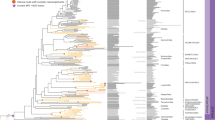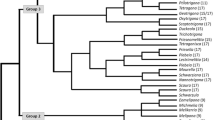Abstract
An analysis of the haploid chromosome numbers of 97 species of the familyNoctuidae was performed. These numbers added to those formerly known, give the picture of an astonishing stability in the whole family with the exception of one genus,Orthosia, in which a wide variation was found. In 105 out of 112 species of non-Orthosia noctuids the haploid number is 31, which is thus the modal number of the family. In sharp contrast to this pattern, inOrthosia each of the 8 species investigated gives a different chromosome count, ranging from 14 to 120, and none has 1he number 31. The chromosomes are large in the speciesOrthosia gracilis, which has 14 chromosomes, smaller in the species with intermediate numbers, and smallest in the speciesO. rorida, possessing 120 chromosomes. The differences in number are therefore interpreted as mainly due to fusion and fragmentation processes, which should be facilitated by the holokinetic organisation of the Lepidoptera chromosomes. In non-Orthosia noctuids the volumes of chromosome complements differ as much as 1∶5 in spite of the constant chromosome number. The existence of a mecanism is postulated which prevents easy fusion and fragmentation in non-Orthosia noctuids and many of the other Lepidoptera lines.
Similar content being viewed by others
Literatur
Aubert, J.-F. &Ch. Boursin (1953). Les Phalénides (Noctuelles) du Jura (révision de la nomenclature et introduction à la Faune des Macrolépidoptères du Jura).Bull. mens. Soc. linn. Lyon 22: 115–126.
Bauer, H. (1967). Die kinetische Organisation der Lepidopteren-Chromosomen.Chromosoma 22: 101–125.
Beliajeff, N. K. (1930). Die Chromosomenkomplexe und ihre Beziehung zur Phylogenie bei den Schmetterlingen.Z. indukt. Abstamm.-u. VerebLehre 54: 369–399.
Bigger, T. R. L. (1960). Chromosome numbers of Lepidoptera. Part I.Entomologists' Gaz. Feltham 11: 149–152.
Bigger, T. R. L. (1961). Chromosome numbers of Lepidoptera. Part II.Entomologists' Gaz. Feltham 12: 85–89.
Boursin, Ch. (1964). Les Noctuidae Trifinae de France et de Belgique (contribution à l'étude des Noctuidae Trifinae, 148).Bull. mens. Soc. linn. Lyon 33: 204–240.
Burgeff, H. &G. Haupt (1967). Chromosomenzahlen bei der Gattung Zygaena (Lep.).Nachr. Akad. Wissensch. Göttingen, math.-phys. Kl. 9, 89–94.
Kockayne, E. A. (1952). The chromosome number of Leucania favicolor Barret and Leucania pallens Linnaeus.Ent. Rec. 64: 220–221.
Cook, M. H. (1910). Spermatogenesis in Lepidoptera.Proc. Acad. nat. Sc. Philad. 62: 294–327.
Dufay, C. (1961). Faune terrestre et d'eau douce des Pyrénées-Orientales: Lépidoptères. I. Macrolépidoptères.Suppl. Vie et Milieu 12: 1–148.
Federley, H. (1938). Chromosomenzahlen finnländischer Lepidopteren. I. Rhopalocera.Hereditas 24: 397–464.
Federley, H. (1943). Zytogenetische Untersuchungen an Mischlingen der Gattung Dicranura B. (Lepidoptera).Hereditas 29: 205–254.
Forster, W. &T. Wohlfahrt (1971). Die Schmetterlinge Mitteleuropas. Bd. 4. Franckh'sche Verlagsanstalt, Stuttgart.
Friedländer, M. &J. Wahrman (1970). The spindle as a basal body distributor. A study in the meiosis of the male silkworm moth, Bombyx mori.J. Cell Sci. 7: 65–89.
Gupta, Y. (1964). Chromosomal studies in some Indian Lepidoptera.Chromosoma 15: 540–561.
Hughes-Schrader, S. &H. Ris (1941). The diffuse spindle attachment of coccids, verified by the mitotic behaviour of induced chromosome fragments.J. exp. Zool. 87: 429–456.
Hughes-Schrader, S. &F. Schrader (1956). Polyteny as a factor in the chromosomal evolution of the Pentatomini (Hemiptera).Chromosoma 8: 135–151.
Hughes-Schrader, S. &F. Schrader (1961). The kinetochore of the Hemiptera.Chromosoma 12: 327–350.
Kernewitz, B. (1914). Über Spermiogenese bei Lepidopteren.Zool. Anz. 45: 137–139.
Kernewitz, B. (1915). Spermiogenese bei Lepidopteren mit besonderer Berücksichtigung der Chromosomen.Arch. Naturgesch., A 81: 1–34.
Keyl, H. G. (1965). Duplikation von Untereinheiten der chromosomalen DNS während der Evolution von Chironomus thummi.Chromosoma 17: 139–180.
Kiauta, B. (1968): Distribution of the chromosome numbers in Trichoptera in the light of phylogenetic evidence.Genen Phaenen 12: 110–113.
Lesse, H. De (1954). Formules chromosomiques nouvelles chez les Lycaenidae (Lépidoptères Rhopalocères).C.r. Acad. Sci. (Paris) 238: 514–516.
Lesse, H. De (1959). Caractères et répartition en France d'Erebia aethiopellus Hoffmsg. et E. mnestra Hb.Alexanor 1: 72–81.
Lesse, H. De (1960). Speciation et variation chromosomique chez les Lépidoptères Rhopalocères.Annls Sci. nat. Zool. Sér. 12,2: 1–223.
Lesse, H. De (1964). Les nombres de chromosomes chez quelques Erebia femelles (Lep. Satyrinae).Revue. fr. Ent. 31: 112–115.
Lesse, H. De (1967). Les nombres de chromosomes chez les Lépidoptères Rhopalocères néotropicaux.Annls Soc. ent. Fr., N.S. 3: 67–136.
Lesse, H. De (1970). Les nombres de chromosomes dans le groupe de Lysandra argester et leur incidence sur sa taxonomie.Bull. Soc. ent. Fr. 75: 64–68.
Lorkovic, Z. (1941). Die Chromosomenzahlen in der Spermatogenese der Tagfalter.Chromosoma 2: 155–191.
Lorkovic, Z. (1949). Chromosomenzahlen-Vervielfachung bei Schmetterlingen und ein neuer Fall fünffacher Zahl.Rev. suisse Zool. 56: 243–249.
Maeda, T. (1939). Chiasma studies in the silkworm Bombyx mori L.Jap. J. Genet. 15: 118–127.
Maeki, K. (1957). A cytological study in 16 species of the Japanese Papilionidae.La Kromosomo 32: 1115–1122.
Maeki, K. (1958). On the cytotaxonomical relationship in Leptidea (Lepidoptera-Rhopalocera).Jap. J. Genet. 33: 283–285.
Maeki, K. &S. A. Ae (1966). A chromosome study of twenty-eight species of Himalayan butterflies (Papilionidae, Pieridae).Spec. Bull. Lepid. Soc. Japan 2: 107–120.
Nordenskiöld, H. (1963). A study of meiosis in the progeny of X-irradiated Luzula purpurea.Hereditas 49: 33–47.
Regnart, H. (1933). Additions to our knowledge of chromosome numbers in the Lepidoptera.Proc. Univ. Durham, phil. Soc. 9: 79–83.
Robinson, R. (1971). Lepidoptera genetics. Pergamon Press, Oxford.
Saitoh, K. (1959). The chromosomes of some species of moths.Jap. J. Genet. 34: 84–87.
Saitoh, K. (1960). A chromosome survey in thirty species of moths.Jap. J. Genet. 35: 41–48.
Schrader, F. &S. Hughes-Schrader (1956). Polyploidy and fragmentation in the chromosomal evolution of various species of Thyanta (Hemiptera).Chromosoma 7: 469–496.
Seiler, J. (1914). Das Verhalten der Geschlechtschromosomen bei Lepidopteren. Nebst einem Beitrag zur Kenntnis der Eireifung, Samenreifung und Befruchtung.Arch. Zellforsch. 13: 159–269.
Seiler, J. (1965). Untersuchungen über die Entstehung der Parthenogenese bei Solenobia triquetrella F.R. (Lepidoptera, Psychidae). VI. Mitteilung. Umbau im Karyotyp der diploid parthenogenetischen S. triquetrella von Alpe di Melano, nebst Bemerkungen über Komplexchromosomen.Chromosoma 16: 463–476.
Seiler, J. &C. B. Haniel (1921). Das verschiedene Verhalten der Chromosomen in Eireifung und Samenreifung von Lymantria monacha L.Z. indukt. Abstamm.-u. VererbLehre 27: 81–103.
Smith, S. G. (1944). The reproduction of the nucleus.Scient. Agric. 24: 491–509.
Suomalainen, E. (1953). The kinetochore and the bivalent structure in the Lepidoptera.Hereditas 39: 88–96.
Suomalainen, E. (1965). On the chromosomes of the geometrid moth genus Cidaria.Chromosoma 16: 166–184.
Suomalainen, E. (1969a). Chromosome evolution in the Lepidoptera.Chromosomes Today 2: 131–138.
Suomalainen, E. (1969b). On the sex chromosome trivalent in some Lepidoptera females.Chromosoma 28: 298–308.
Traut, W. &G. C. Mosbacher (1968). Geschlechtschromatin bei Lepidopteren.Chromosoma 25: 343–356.
Ullerich, F.-H. (1966). Karyotyp und DNS-Gehalt von Bufo bufo, B. viridis, B. bufo x B. viridis und B. calamita (Amphibia, Anura).Chromosoma 18: 316–342.
Ullerich, F.-H. (1967). Wietere Untersuchungen über Chromosomenverhältnisse und DNS-Gehalt bei Anuren (Amphibia).Chromosoma 21: 345–368.
Ullerich, F.-H. (1970). DNS-Gehalt und Chromosomenstruktur bei Amphibien.Chromosoma 30: 1–37.
White, M. J. D. (1954). Animal cytology and evolution. (2nd Edition) University Press, Cambridge.
White, M. J. D. (1957). Some general problems of chromosomal evolution and speciation in animals.Surv. biol. Prog. 3: 109–147.
WHITE, M. J. D. (1959). Telomeres and terminal chiasmata—a reinterpretation.Texas Univ. Biol. Contrib. 5914: 107–111.
Author information
Authors and Affiliations
Rights and permissions
About this article
Cite this article
Werner, L. Zur Evolution des Karyotyps bei den Lepidopteren. Die Chromosomenzahlen der Noctuiden. Genetica 45, 377–395 (1975). https://doi.org/10.1007/BF01508313
Received:
Accepted:
Issue Date:
DOI: https://doi.org/10.1007/BF01508313




